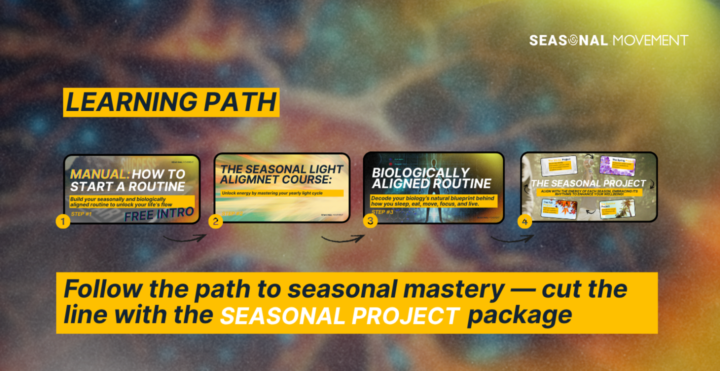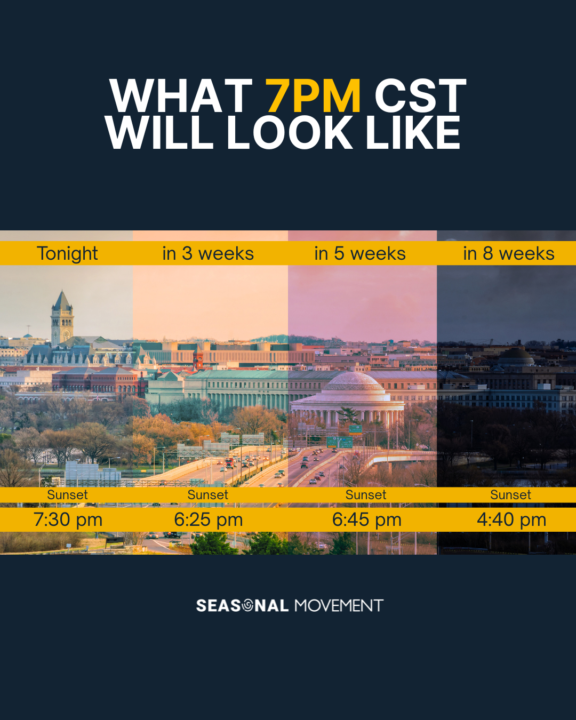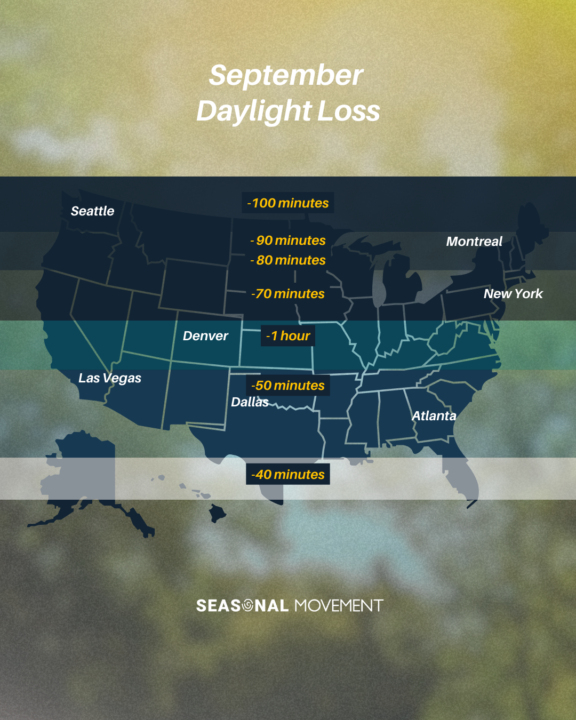Activity
Mon
Wed
Fri
Sun
Jan
Feb
Mar
Apr
May
Jun
Jul
Aug
Sep
Oct
Nov
Dec
What is this?
Less
More
Owned by Ruben
Harness seasonal energy with scientifically backed seasonal routines to boost overall well-being throughout the year.
Memberships
Community Creators Club
6.2k members • Free
Skool Speedrun (Free)
11.6k members • Free
High Vibe Tribe
78.3k members • Free
19 contributions to The Seasonal Movement
🌿 Start Your Seasonal Journey
Welcome to The Seasonal Movement! Here’s your path to align your rhythm, energy, and lifestyle: 1️⃣ Manual: How to Start a Routine (Free Intro) 2️⃣ The Seasonal Light Alignment Course 3️⃣ Biologically Aligned Routine 4️⃣ The Seasonal Project — your full transformation ⚡ Ready to go all in? Follow the full path — or cut the line with the SEASONAL PROJECT package to reach mastery faster.
1
0

🌞 Summer vs ❄️ Winter: Why the Same Habits Don’t Work
For years, summer was my season. The long days, the warm light, that endless energy… everything seemed to click. My routines thrived. I trained harder, worked faster, created more. It felt like nothing could stop me. But then winter came. And it always did. It was like hitting an invisible wall. The same habits that worked in summer completely failed me. My focus slowed, energy dipped, motivation faded. No matter how much I pushed, nothing worked the same way. Like many people, I blamed myself. I thought I needed more discipline, more hacks, more willpower. 👉 The truth was simpler (and way more powerful): Your environment changes with the seasons — and so does your biology. When I began matching my habits to the season, working with my biology instead of against it… everything shifted. I stopped burning out. My business stayed steady. My personal life felt balanced. And here’s the twist: winter became my favorite season. It’s when I now grow the most, because I’ve learned to adapt, reset, and use the rhythm of the year to my advantage. 💡 Sustainable growth isn’t about pushing harder all the time. It’s about knowing when to push, when to recover, and how to let the seasons shape your strategy. So let me ask you: ➡️ Are you still forcing “summer habits” into winter conditions? ➡️ Or are you adjusting to thrive year-round?
1
0
Thrive This Season
BOOK A CALL (FREE) and let’s design your best season yet. Seasonal change can throw everything off—your energy, your focus, even your mood. But here’s the truth: with the right alignment, this can also be the season where you thrive. I’ve helped many align their routines around these natural shifts… and I’d love to help you too.
1
0

The Loss of Light and Its Impact on Daily Life
As the seasons change, there’s a phenomenon we often underestimate: the reduction of daylight hours. What is today a 7:30 pm sunset will, in just a few weeks, turn into complete darkness at the same time. Within two months, the light that fills our afternoons will vanish long before our day is truly over. This transition is not just an aesthetic detail of the landscape; it has a profound effect on both our bodies and our minds. The biological clock and light: Our bodies are guided by an internal system called the circadian rhythm, which regulates sleep, energy, appetite, and mood. Sunlight is the main signal that synchronizes this inner clock. When darkness arrives earlier, the brain interprets it as the end of the day and begins to release melatonin, the sleep hormone, making us feel tired even when our schedule still demands activity. Routine under pressure: In summer, finishing work while there’s still daylight allows time for exercise, socializing, or simply enjoying the evening. But in fall and winter, the lack of light disrupts these routines. The workday ends, yet the surroundings are already dark, often leading to sedentarism, isolation, and a premature sense that the day is “over.” Emotional and physical impact: The reduction of natural light also affects the production of serotonin, a neurotransmitter linked to motivation and well-being. This is why many people experience seasonal affective disorder (SAD): apathy, sadness, and low energy that coincide with the darkest months of the year. In addition, reduced sunlight exposure lowers the synthesis of vitamin D, which is essential for bone health, immune function, and hormonal balance. How to adapt to earlier darkness: While we cannot stop the seasons from changing, we can adjust our routines: - Maximize natural light: walk or work near a window in the morning. - Use proper artificial light: full-spectrum lamps can help compensate for the lack of sunlight. - Plan physical activity earlier: moving the body before nightfall sustains energy and mood. - Create transition rituals: use darkness as a cue for rest, but not as an excuse to shut down social or personal life.
1
0

September: The month when daylight disappears the fastest
As summer fades and autumn approaches, nature reminds us of an inevitable shift: the days grow shorter, and they do so at a faster pace in September than in any other month of the year. September is when we lose the most daylight minutes each day, all due to the tilt of Earth’s axis and its orbit around the Sun. How much daylight do we lose? - In the northern states, such as Montana and the Dakotas, as much as 100 minutes of daylight are lost throughout September. - In the central regions, cities like Denver or Kansas City experience around 70 minutes of loss. - In the southern states, from Texas to Florida, the decrease is smaller but still noticeable: between 40 and 50 minutes. This phenomenon occurs because the Northern Hemisphere gradually tilts away from the Sun after the summer solstice in June. In September, this change accelerates, paving the way for the autumn equinox (around September 22 or 23), when day and night are nearly equal all over the world. More than just an astronomical fact The loss of daylight impacts much more than just the length of our days: - Mood and energy: Many people feel more tired or melancholic, a prelude to what is known as Seasonal Affective Disorder (SAD). - Nature: Plants, animals, and entire ecosystems respond to this shift in light by adjusting their biological rhythms. - Daily life: Outdoor activities get shorter, and our sense of time can make it feel like the days “fly by” more quickly. A reminder of natural cycles: While it may seem that darkness is gaining ground too quickly, this adjustment is part of Earth’s natural balance. The shortening of daylight in September prepares us for the calm of autumn and the stillness of winter, reminding us that life flows in cycles and that every season has its own purpose.
0
0

1-10 of 19
@ruben-gomez-1017
Founder of the Seasonal Movement. Inspired by S.A.D, committed to seasonal flow and aligning with nature’s rhythms for harmony and peak performance.
Active 6d ago
Joined Jan 21, 2025
Omaha, NE
Powered by

